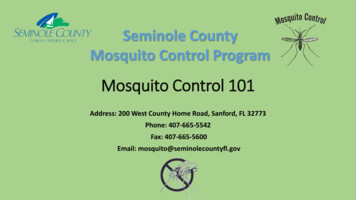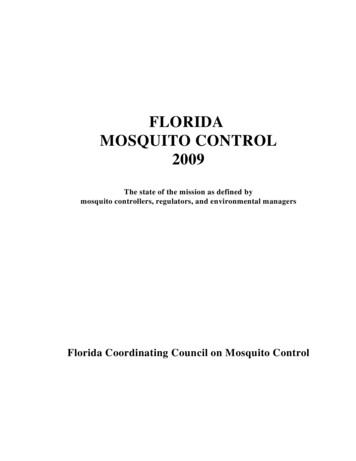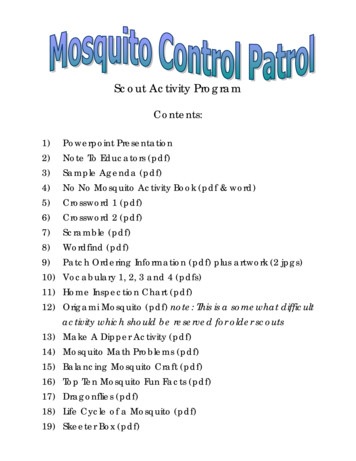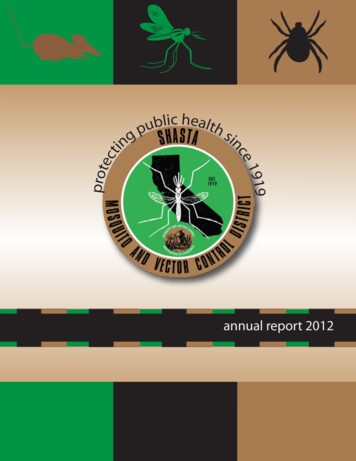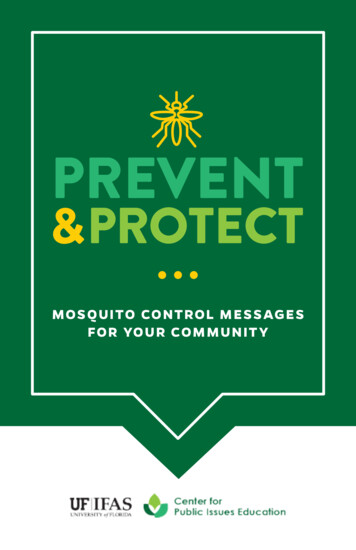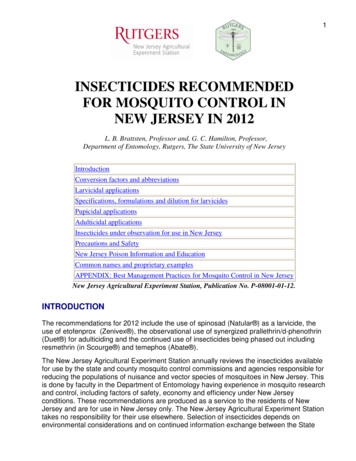
Transcription
1INSECTICIDES RECOMMENDEDFOR MOSQUITO CONTROL INNEW JERSEY IN 2012L. B. Brattsten, Professor and, G. C. Hamilton, Professor,Department of Entomology, Rutgers, The State University of New JerseyIntroductionConversion factors and abbreviationsLarvicidal applicationsSpecifications, formulations and dilution for larvicidesPupicidal applicationsAdulticidal applicationsInsecticides under observation for use in New JerseyPrecautions and SafetyNew Jersey Poison Information and EducationCommon names and proprietary examplesAPPENDIX: Best Management Practices for Mosquito Control in New JerseyNew Jersey Agricultural Experiment Station, Publication No. P-08001-01-12.INTRODUCTIONThe recommendations for 2012 include the use of spinosad (Natular ) as a larvicide, theuse of etofenprox (Zenivex ), the observational use of synergized prallethrin/d-phenothrin(Duet ) for adulticiding and the continued use of insecticides being phased out includingresmethrin (in Scourge ) and temephos (Abate ).The New Jersey Agricultural Experiment Station annually reviews the insecticides availablefor use by the state and county mosquito control commissions and agencies responsible forreducing the populations of nuisance and vector species of mosquitoes in New Jersey. Thisis done by faculty in the Department of Entomology having experience in mosquito researchand control, including factors of safety, economy and efficiency under New Jerseyconditions. These recommendations are produced as a service to the residents of NewJersey and are for use in New Jersey only. The New Jersey Agricultural Experiment Stationtakes no responsibility for their use elsewhere. Selection of insecticides depends onenvironmental considerations and on continued information exchange between the State
2and Federal authorities and the professional organizations in mosquito research and controlin New Jersey. Professional mosquito control in New Jersey relies on the surveillance ofmosquito sources and problems and the proper consideration of options for control, such aswater management, biological control, and insecticides. This integrated and comprehensiveapproach to the control of mosquitoes utilizes all available control strategies to reduce theoccurrence of mosquitoes as pests to tolerable levels while maintaining a qualityenvironment.When mosquito problems necessitate the use of insecticides, it is generally best to employlarvicides and pupicides, as they are directed at the most concentrated developmentalstages of the mosquito population and reduce the need for large-scale and expensiveadulticiding. Only the public county and state commissions or agencies charged with theresponsibility for mosquito control may perform mosquitocidal applications on any scale,large or small. If weather or environmental concerns prevent larviciding, adulticides can beused shortly after emergence before adult mosquitoes have dispersed. The purpose ofmosquito control is to reduce nuisance and disease potential, not to eradicate mosquitoes.Adulticiding may be necessary for dispersed or migrating adult mosquitoes but should beavoided. Special attention should be given to the level of mosquito activity and theprevailing environmental conditions in order to insure maximum efficiency of the application.All applications of insecticides for larviciding, pupiciding, or adulticiding purposes must beconsistent with and comply with the principles of integrated pest management (IPM) asdescribed in the APPENDIX (starting on page 12), entitled “Best Management Practices forMosquito Control in New Jersey”. This text (revised in 2008) is an excerpt of all clausespertaining to mosquito control in New Jersey from “The Environmental Protection Agency’sPesticide Environmental Stewardship Program“ and contains detailed and comprehensive(http://www-rci.rutgers.edu/ insects/psd.htm), information on integrated practices formosquito control in New Jersey.For the benefit of mosquito control in New Jersey, information gathered on control efficacyfor the target species and any effects observed on non-target species in trial applications ofinsecticides not included in these recommendations should be shared with members of theAssociated Executives of Mosquito Control Work in New Jersey and the NJAES (write to ore-mail Dr L. B. Brattsten, Rutgers University, Department of Entomology, Blake Hall, 93Lipman Drive, New Brunswick, NJ 08901; brattsten@aesop.rutgers.edu). Please include inyour letter details of locations and target species. All such applications of insecticidesshould follow the manufacturer’s recommendations.Just as bacteria evolve resistance to antibiotics, mosquitoes evolve resistance toinsecticides used for their control. Selection for resistance can result from the repeated useof the same insecticide exclusively and from slow-release formulations of insecticides. Toavoid or delay resistance, a variety of different insecticides and other control methods mustbe used in rotation. Reliance on a single insecticide frequently or over large contiguousareas is likely to produce resistance to that control agent and can also cause crossresistance to other insecticides. The major larvicides recommended for use in New Jersey,temephos, S-methoprene, spinosad, and BTI are ideal for use in rotations as each has lowenvironmental stability, a separate molecular mode of action, and significant differences indetoxification mechanisms. For adulticiding, malathion is the least likely to trigger evolutionof resistance and synergized pyrethroids the most likely.
3The table below shows the major modes of detoxification of the three adulticides and thefour available larvicides in most mosquitoes. The enzymes catalyzing the oxidations are thelarge family of cytochrome P450 multipurpose monooxygenases; the enzymes catalyzingthe hydrolyses are the equally large family of esterases. BTI is detoxified by a special caseof hydrolysis catalyzed by esterase-related peptidases. Laying a selection pressure onoxidation, for instance, by heavy use of piperonyl butoxide-synergized pyrethroids may driveevolution towards heavier reliance on hydrolysis. This implies one type of possible crossresistance between insecticides.Detoxified proxXBTISpecial XTemephosXSpinosadXMethopreneXXThe table below shows the molecular target sites for insecticides used for mosquito controlin New Jersey. It’s a good idea to rotate these insecticides to avoid resistance evolution bytarget site mutations, a more difficult type of resistance to overcome than metabolicresistance.InsecticidesMode of actionMalathionNerve: acetylcholinesterase inhibitorResmethrinNerve: sodium channel interferenceEtofenproxNerve: sodium channel interferenceBtiCell membrane destructionTemephosNerve: acetylcholinesterase inhibitorSpinosadNerve: acetylcholine receptorMethopreneJuvenile hormone agonist
4If pyrethroids or synergized pyrethroids must be used, the NJAES recommends thecontinued use of resmethrin-containing Scourge for as long as it is commercially available.All pyrethroids are potential endocrine disruptors and should be used sparingly and withappropriate precautions.For any application of an insecticide by a mosquito control professional, including anypesticide application in public places, the applicator or the direct supervisor must be certifiedand licensed as a “Commercial Pesticide Applicator” by the NJ DEP PCP Bureau ofPesticide Operations (N.J.A.C. 7:30-6). The correct license category is Category 8B Mosquito Control. The Category 8C – Campground Pest Control license may be appropriateunder certain circumstances. Pilots applying insecticides to control mosquitoes must haveCategory 11 - Aerial Pest Control in addition to 8B - Mosquito Control. The same holds truefor research and demonstration applications, Category 10 - Demonstration and ResearchPest Control and 8B - Mosquito Control are required. Training manuals may be obtainedfrom your local county cooperative extension office. Certified and licensed applicators mayhave employees applying insecticides using non-aerial equipment under their directsupervision provided that these employees are registered as “Commercial PesticideOperators” (N.J.A.C. 7:30-5). Contact the New Jersey Department of EnvironmentalProtection, Pesticide Control Program (www.pcpnj.org) in Trenton for additional informationregarding pesticide applicator permit details, 1 609 984 6614.Common names of insecticides (along with Trade Names ) are used in the interest ofincreasing the understanding of the materials used. The trade or brand names given hereinare supplied with the understanding that no discrimination is intended (against similarproducts not mentioned) and no endorsement by the New Jersey Agricultural ExperimentStation is implied.CONVERSION FACTORS AND ABBREVIATIONSTo aid in the use of the metric system, the rates and dilutions in these recommendations aregiven in the metric system units with the United States equivalent in parenthesis. Below is alist of the conversion factors and abbreviations used in these recommendations:1 kilogram, kg 2.2 pounds, lbs1 gram, g 0.002 lbs1 hectare, ha 2.47 acres1 liter, L 1.056 quarts1 milliliter, mL 0.001 L1 fl ounce, oz 29.6 mL1 lb/acre 1.12 kg/ha1 pint/acre 1.17 L/ha1 quart/acre 2.34 L/ha1 fl oz/acre 73.2 mL/haactive ingredient (AI); aqueous suspension (AS); emulsifiable concentrate (EC);extended release (XR); kilometer per hour (kph); international toxic units (ITU)
5LARVICIDAL APPLICATIONSThe following insecticides are recommended for the control of larvae of nuisance and vectorspecies in various larval habitats. The insecticides are listed alphabetically, not in order ofexpected efficacy.A. Catch basins(1) Temephos (Abate emulsion or 5% extruded pellets according to product label.(2) S-methoprene (Altosid Aquaprene ) pellets and standard briquets according toproduct label.(3) Monomolecular films (Agnique MMF, Golden Bear Oil, i.e. Mosquito Larvicide GB1111 ) as a larvicide/pupicide, according to product label.(4) Bacillus thuringiensis israelensis serotype H-14 (BTI) briquets or other formulations,including Aquabac , Teknar , Vectobac 12AS, Bactimos (see B3).(5) Bacillus sphaericus (BSP) (see C4), including Vectolex WSP (7.5% BSP)water-soluble pouch for use in catch basins.(6) Spinosad (Natular XRG multiple-brood extended release granules, according toproduct label.B. Fresh flood water areas, woodland pools(1) Temephos (Abate emulsion, granules, 5% extruded pellets according to productlabel.(2) S-methoprene (Altosid Aquaprene ) liquids, pellets, or briquets (standard)according to label.(3) BTI (Vectobac ) according to manufacturer’s directions. BTI must be ingested to betoxic and is therefore toxic only to actively feeding mosquito larvae. The activeingredient in BTI formulations (e.g., flowables, briquets, granulars, and pellets) mayvary and is given as a percent (11.6% in Vectobac 12AS) and represented asInternational Toxic Units (ITU) per mg. Where such formulations are meant to besuspended in water for application, agitation must be provided to insure uniformapplication.(4) Spinosad (Natular EC or G single-brood liquid or granules, according to productlabel.C. Polluted and/or impounded waters(1) Temephos (Abate emulsion, 1 or 2% granules, 5% extruded pellets according toproduct label. See also E3.(2) S-methoprene (Altosid Aquaprene ) liquids, pellets, briquets (standard) accordingto label.(3) Monomolecular films (Agnique MMF, Golden Bear Oil, i.e., Mosquito Larvicide GB1111 ) as a larvicide/pupicide, according to product label.(4) BSP recommended for the control of Culex larvae: use according to manufacturer’sdirections. BSP may also be an effective larvicide for non-Culex species.(5) Spinosad (Natular XRG multiple-brood extended release granules, according toproduct label.
6D. Prehatch for woodland pools with a record of annual early larval activities(1) S-methoprene (Altosid Aquaprene ) pellets briquets (standard) according toproduct label.(2) BTI briquets, according to product label.(3) Spinosad (Natular EC or G single-brood liquid or granules, according to productlabel.E. Salt marsh(1) The use of larvicides on the open tidal marsh should be in conjunction with a planinvolving water management for long-term reduction of the mosquito problem and ofinsecticide use. Heavy rains or exceptionally high tides may make it necessary toreapply larvicides in defined areas.(2) Temephos (Abate 2% or 5% granules, emulsion, in sufficient water to accomplishefficient distribution at rates according to product label.(3) S-methoprene (Altosid Aquaprene ) (see B2).(4) BTI (see B3).(5) Spinosad (Natular EC or G single-brood liquid or granules, according to productlabel.F. Fresh water marsh(1) Temephos (Abate (see B1).(2) S-methoprene (Altosid Aquaprene ) (see B2); liquids, pellets, briquets (standard)according to product label.(3) BTI (see B3).(4) Spinosad (Natular EC or G single-brood liquid or granules, according to productlabel.SPECIFICATIONS, FORMULATIONS and DILUTIONS for LARVICIDESEmulsifiable concentratesThese formulations, which are to be diluted with water prior to spraying, may contain asmall percentage of volatile solvent.Dilution of concentratesTemephos (Abate emulsions are prepared from a 4E concentrate 0.48 kg/L (4 lbs/gallon). For most larviciding, dilute 36.6 mL in 93.5 L water/ha (0.5 fl oz in 10 gallonswater/acre). For waters high in organic matter content, the concentration may beincreased 2-3 fold.Granular larvicidesAll granular formulations should be formulated to insure efficient release of theinsecticide in water. Temephos (Abate granules may employ carriers such as sand,celatom, Plaster of Paris, or Biodac (a cellulose product); inclusion of an oil solventdoes not appear necessary. S-methoprene (Altosid Aquaprene ) carriers includePlaster of Paris and Biodac . No highly volatile solvents should be used in granularformulations. For celatom carrier, the optimum particle size for aircraft application is24/48, with no more than 15% above 48 mesh, to minimize drift. For ground application,
730/60 to 60/80, depending on equipment, is optimum; more than 10% (by weight) inparticles outside these specified size ranges is considered unsatisfactory.PUPICIDAL APPLICATIONSThe pupal stage is the briefest stage in the development of the mosquito. As pupae areunaffected by organophosphates, pyrethroids, and other nerve poison type insecticides,BTI, or S-methoprene, there are few effective pupicides. These agents will also controlfourth instar larvae, which may be present when it is necessary to pupicide. As withlarviciding, timely efforts to control concentrated populations of pupae can be of value inpreventing the emergence of adult mosquitoes and reducing the need to adulticide. Thefollowing type of insecticide is recommended for the control of pupae of nuisance and vectorspecies.Monomolecular films (Agnique MMF, Golden Bear Oil 1111, Bonide MosquitoLarvicide) according to product labels.ADULTICIDAL APPLICATIONSWhile the control of mosquitoes is generally most efficiently accomplished in the immaturestages, conditions may sometimes necessitate the use of adulticides. If agencies other thancounty mosquito control commissions or agencies responsible for mosquito control wish toadulticide, they should contact the NJ Pesticide Control Program (609-984-6666)concerning regulations. Community or area-wide notification of adulticiding is requiredaccording to NJAC 7:30-9.10 (www.pcpnj.org).Particular attention should be given to temperature, as it may affect droplet behavior, andthe toxicity of the insecticide to the target mosquito. Of the types of adulticiderecommended, the organophosphate malathion has a positive temperature coefficient, i.e.,more toxic at higher temperatures; resmethrin and other pyrethroids have a negativetemperature coefficient, i.e., they are more toxic at lower temperatures. Ambienttemperature, therefore, can influence the selection of insecticide.The New Jersey Agricultural Experiment Station recommends the following adulticidemeasures. Synergized pyrethroid formulations (Scourge , Anvil Duet ) should be usedas rarely as possible and not over large contiguous areas to avoid or delay insecticideresistance evolution in local populations. Synergized pyrethroid formulations are mostappropriately used only for barrier treatments.A. Adulticiding with ground equipment1. Thermal aerosols, foggingInsecticide fogging can be an effective method in mosquito control. It is not meant to beused routinely but only when populations of adult mosquitoes reach public health ornuisance levels. These levels are highly variable and depend on the mosquito speciesinvolved as well as local environmental conditions. The final decision to fog should rest with
8the mosquito control professionals in each county. Trained personnel at these institutionsare expertly knowledgeable about local mosquito populations and conditions. When foggingis deemed necessary, the following physical conditions, mostly encountered in the earlyevening and morning hours, should exist:a. Air temperature: 15 C or higher (60 F)b. Light intensity: below 20 foot candles, with light meterc. Wind velocity: 5-8 kph (3 to 5 mph)d. Stable thermal conditions to allow the fog to travel at ground level.The only material recommended for fogging is malathion. The 95% malathion concentrateshould be diluted as follows for fogging: 15 L (4 gal) concentrate is added to sufficientsolvent to make 379 L (100 gal) final volume (0.4%). The diluted material is applied at a flowrate of 151 L/h (40 gal/h) with a vehicle speed of 8 kph (5 mph). An experienced andknowledgeable operator and a properly equipped vehicle and fogger are absolutelyessential.Per label, attention should be given to the flash point of the solvent used as measured bythe “closed cup” method.2. Sprays by mist blowers and hydraulic sprayersWhile mainly intended for use with residual insecticides, this equipment can be employed toapply dilute emulsions of the non-persistent insecticide malathion to foliar surfaces for shortterm residual mosquito control. The materials should be diluted and applied according tolabel recommendations for such equipment.3. ULV (ultra low volume) spray applied by ground equipmentThe technique of ULV has the advantage over fogging of being less dense and, therefore,less hazardous in urban traffic. Physical conditions as stated for fogging are generallydesirable, and application should coincide with times of maximum adult mosquito activity inorder to achieve maximum efficiency.The technique of ULV employs more concentrated insecticides and the equipment for theirapplication must be properly calibrated and serviced. Ground ULV applications do notalways penetrate dense foliage as well as do fogging applications. Application of anyground ULV material should be performed under conditions also known to be best forefficient fogging operations (A1 above); wind speeds up to 16 kph (10 mph) are acceptable.Application should be made after sunset or before sunrise at temperatures of 15 to 28 C (60to 82 F).(a) Malathion (Fyfanon , Atrapa , 96-98%) at the flow rate of 90 mL/min at 16 kph or 45mL/min at 8 kph (3 fl oz/min at 10 mph or 1.5 fl oz/min at 5 mph). With a constantvolume flow meter and depending on conditions, e.g., acreage to be treated and periodof mosquito activity, application may be made at 20 mph. According to the labeling ofthese products, their application by ground ULV is restricted to professional mosquitocontrol personnel who have the experience, knowledge and equipment necessary tofollow the technical instructions for their use.(b) Pyrethroid/piperonyl butoxide mixtures such as Scourge (resmethrin/piperonyl butoxidein a 1:3 ratio), Anvil (d-phenothrin/piperonyl butoxide 2 2) or Duet (d-phenothrin/
9prallethrin/ piperonyl butoxide – 5/1/5). Scourge (4 12) is available in a formulationfor use without further dilution. Use these products according to instructions on the labeland as seldom as possible.B. Adulticiding by aircraftApplication from aircraft may only be performed according to Federal Aviation Regulations,by the county mosquito control commissions, equivalent county units, or the State MosquitoControl Commission using materials specifically labeled for application by aircraft (N.J.A.C.7:30-6.3). To insure that the droplets descend from the aircraft to the areas of mosquitoactivity, these applications should be made close to sunset or thereafter, or early morning,when a deep temperature inversion occurs. For further discussion of this aspect see A. V.Havens, Proc. N. J. Mosq. Ext. Assoc., 60:59-63 (1973).1. LV (low volume) spraying(a) 148 mL of 96-98% malathion per 2.3 L of No. 2 fuel oil/ha (2 fl oz 95% malathion in 1quart of solvent/acre) (EPA SLN No. NJ-950003).(b) Etofenprox (Zenivex E20, requiring dilution or Zenivex E4, ready to use) according tomanufacturer’s directions.2. ULV (ultra low volume) spraying(a) 220 mL/ha (3 fl oz /acre) of 96-98% malathion as applied by fixed wing aircraft orhelicopter equipped with a rotary atomizer (e.g., a Beecomist nozzle) according toinsecticide manufacturer’s specifications with the additional stipulation that wind velocitybe no greater than 8-16 kph (5-10 mph). To insure that the equipment performs correctlyand produces proper droplet sizes, the equipment should be periodically calibrated andexamined closely. Systems should include elements for positive shutoff of delivery.Spray droplet size should be determined periodically. To prevent malfunction of thesystem, the malathion should be filtered just prior to use by a method similar to thatdescribed by H. R. Rupp, Mosquito News, 33:463-464 (1973).(b) Resmethrin/Piperonyl butoxide in a ratio of 1:3 by weight, such as Scourge at ratesaccording to the label.(c) Etofenprox (Zenivex E20, requiring dilution or Zenivex E4, ready to use) according tomanufacturer’s directions.INSECTICIDE FORMULATIONS UNDER OBSERVATION FOR USE IN NEWJERSEYSeveral other released materials could be useful for mosquito control in New Jersey. Theyhave not yet been fully investigated for suitability. We recommend that exploratoryapplications be performed with the following:Anvil (d-phenothrin 10% PBO 10%) for ground or aerial adulticidingAqua-Reslin (permethrin 20% PBO 20%) for barrier treatmentsDuet (d-phenothrin/ prallethrin/ piperonyl butoxide – 5%/ 1%/ 5%)
10Applications of these materials should be relatively small-scale and employ a variety ofmeasurements of effectiveness, e.g., caged mosquitoes, light trap counts, or landingcounts. It would also be of interest to make qualitative observations of possible effects onnon-target organisms. NJAES relies on results from experimental applications to use fordecisions of the inclusion of these materials in the recommended insecticides.PRECAUTIONS AND SAFETYMost insecticides are not only toxic to mosquitoes but can also be toxic to humans and otherforms of life in the environment. It is necessary for all persons responsible for the use ofinsecticides to recognize this and take precautions to insure that these chemicals not onlydo not cause human illness or death but also absolutely minimally contaminate theenvironment. Further information is available from the National Pesticide Information Center(1 800 858 7378 or at npic.orst.edu). Public notice about planned spray operations must beissued according to NJAC 7:30-9.10 (www.pcpnj.org).Manufacturers are required by law to list on the insecticide label those precautions to befollowed to reduce hazards. Such precautions include not only appropriate concentrations tobe used but also protective clothing for applicators, antidotes for poisoning, and conditionsof storage.Precautions should also be taken at other times. Insecticides should be stored in a mannerinaccessible to people who are not knowledgeable of their toxicity and hazards. Storageshould be in an area set aside solely for that purpose, and the area should be wellventilated to prevent overheating and subsequent noxious fumes of solvents or insecticides.When empty, insecticide containers should be triple rinsed, punctured and disposed ofaccording to the product label, or returned to the supplier. Containers should not be burnedbecause of air pollution by smoke and residual insecticide in the containers. Unusedinsecticides should not be discarded in drainage systems but should be turned over toauthorized agencies for appropriate disposal. Regulations for storage can be found at NJAC7:30-9.5 and 9.6, and general regulations on disposal are at 7:30-9.7. More specificrequirements and guidance for the disposal of waste are available from NJ DEP PCP at 1609 530 4070 or www.pcpnj.org or from NJDEP at 1 877 927 6337.NEW JERSEY POISON INFORMATION AND EDUCATIONDuring the mixing and application of insecticides, all precautions listed on the insecticidelabels should be followed. We recommend establishing background acetylcholinesteraseactivity levels by the appropriate test in all personnel working with organophosphateinsecticides, during periods of extended use, and periodically thereafter. For information andaid regarding acute insecticide poisoning, call either the NJ Poison Information andEducation System, 1 800 222 1222; http://www.njpies.org or the National PesticideInformation Center, 1 800 858 7378; http://npic.orst.edu/ . Please consult available websites for extensive information on safety and other aspects on insecticides.
11NEW JERSEY POISON INFORMATIONAND EDUCATION SYSTEM1 800 222 1222orwww. njpies.orgCOMMON NAMES AND PROPRIETARY EXAMPLESCommon nameProprietary examples Bacillus sphaericus (BSP)VectolexBacillus thuringiensis israelensis (BTI)Bactimos, Teknar, Vectobac, AquabacEthoxylate surfactantAgnique MMFMalathionFyfanon, AtrapaS-MethopreneAltosid, AquaprenePermethrin/piperonyl butoxideAqua-ReslinPetroleum derivativeMosquito Larvicide GB 1111d-PhenothrinSumithrinAnvil 10 nyl butoxideDuetSBP-1382, ScourgeSpinosadNatularTemephosAbated-Phenothrin/ prallethrin/ piperonyl butoxide
12APPENDIX“Best Management Practices for Mosquito Control in New Jersey”*OVERVIEW OF MOSQUITO CONTROL IN NEW JERSEYNew Jersey has a diverse ecology that provides habitat for more than 60 species ofmosquitoes. New Jersey also has more human residents per square mile than any otherstate. At the turn of the 20th century, New Jersey functioned as the center for mosquitoresearch and the early (http://www-rci.rutgers.edu/ insects/wiab.htm) workers developedmany of the basic concepts used in mosquito control today. Their successes led to thecreation of organized, multidisciplinary mosquito control as a proper function ofgovernment. Information sharing among researchers and control workers was recognizedas an important component of responsible mosquito management and was formalized in theearly 1900’s.The philosophy of mosquito control in New Jersey is to target mosquitoes and/or theirhabitat as specifically as possible in a financially efficient manner. Minimizing insecticideimpact on non-target organisms has always been vital to public acceptance and wasincorporated into the goals of the mosquito control community. The need to be specific inthe selection and application of insecticides is fundamental to the methods we use in NewJersey.The sanitation and habitat modification procedures developed or enhanced by the earlymosquito control workers in New Jersey form the foundation for today's source reductionactivities. The water management techniques pioneered by New Jersey's early workershave been honed into the most efficient long term methods available today to reducemosquito production. Enhancement of natural predators was deemed important in the earlydays of mosquito control and is now an accepted component of New Jersey's program thatis funded and coordinated by our state agencies.Surveillance is one of the best tools we have for focusing mosquito control on specific pestand vector species. Sampling and identification allow problem species to be recognized andtargeted for control. Early mosquito control workers in New Jersey benefited greatly from thelandmark investigations of John B. Smith (http://www-rci.rutgers.edu/ insects/early.htm), alegendary taxonomist and founder of organized mosquito control. Surveillance programs tomonitor disease organisms and their mosquito vectors were not available to early workersbut are fundamental to New Jersey's programs today. In New Jersey, the need for control,type of management employed and alternatives to insecticides are all weighed against thesurveillance data we collect.The history of mosquito control in New Jersey shows long standing environmentalawareness and the ability to select insecticides, only when necessary, from the broad arrayof techniques we have at our disposal.
13NEW JERSEY'S CONCEPT OF A RESPONSIBLE MOSQUITO CONTROL PROGRAMMosquito control in the state of New Jersey is mandated by law under Title 26, Chapters 3 &9 of the NJ Health Statutes.Title 26 assigns the control of pest and vector species to county mosquito controlcommissions which function as autonomous units of county government. Activities andexpenditure of funds are overseen by a body of commissioners appointed by the board ofchosen freeholders in each county. Tax levies provide the operational budget on a countyby-county basis. Autonomous mosquito commissions have the powers of a local board ofhealth regarding mosquitoes including the right of entry onto public and private properties.They have the power to make a declaration regarding mosquito nuisance and can issue anabatement notice whenever necessary. Seven New Jersey counties currently maintainautonomous commissions and 14 counties have mosquito control responsibilities assignedto other agencies of coun
under certain circumstances. Pilots applying insecticides to control mosquitoes must have Category 11 - Aerial Pest Control in addition to 8B - Mosquito Control. The same holds true for research and demonstration applications, Category 10 - Demonstration and Research Pest Control and 8B - Mosquito Control are required.
